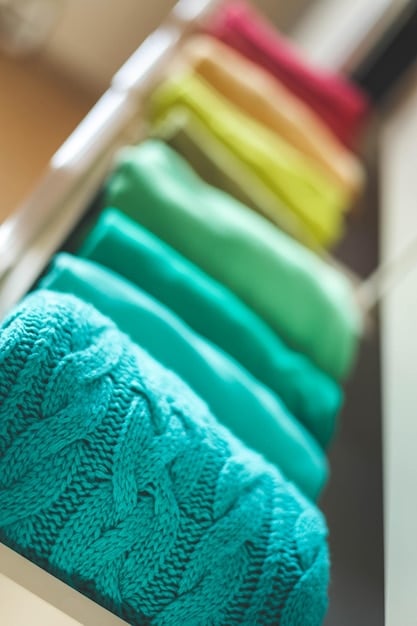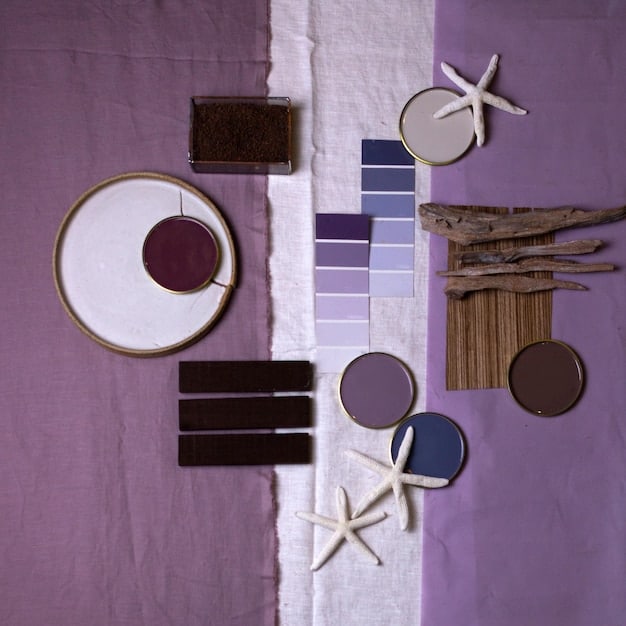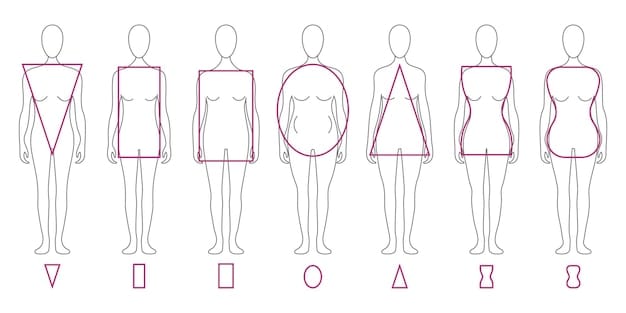Create a Personal Style Guide to Save $500 in 2025

Creating a personal style guide is a strategic approach to refine your wardrobe choices, curb impulse buys, and potentially save $500 or more annually by making informed and confident purchasing decisions in 2025.
Are you tired of impulse buys cluttering your closet? Learn how to create a personal style guide that saves you $500 a year on impulse buys in 2025, ensuring a more curated and cost-effective wardrobe.
Understanding the Importance of a Personal Style Guide
A personal style guide isn’t just about fashion; it’s a roadmap to a more confident and financially savvy you. It helps define your aesthetic preferences, ensuring that every purchase aligns with your overall style goals.
By taking control of your wardrobe choices, you can minimize impulse buys and create a timeless, versatile collection that reflects your unique personality.
Why Create a Style Guide?
Creating a style guide offers numerous benefits beyond just saving money. It helps you develop a cohesive wardrobe, simplifies the shopping process, and boosts your confidence in your clothing choices.
It’s a tool for intentionality, ensuring that your wardrobe is filled with items that you love and feel good in.

- Reduces Impulse Buys: A clear style guide helps you avoid buying items that don’t fit your aesthetic.
- Saves Money: By making intentional purchases, you minimize costly mistakes and wardrobe clutter.
- Boosts Confidence: When your wardrobe reflects your authentic self, you feel more confident and empowered.
- Simplifies Shopping: A style guide streamlines the shopping process, making it easier to find items that align with your style goals.
Ultimately, a personal style guide is an investment in yourself—it empowers you to make informed decisions and create a wardrobe that truly reflects who you are.
Step-by-Step: Defining Your Personal Style
Before diving into the specifics, take some time to reflect on your style preferences, lifestyle, and wardrobe needs. This foundational step sets the stage for creating a style guide that truly resonates with you.
Consider what makes you feel comfortable, confident, and authentic.
Reflect on Your Current Wardrobe
Start by assessing your current wardrobe. Identify the items that you love and wear frequently, as well as the ones that languish in the back of your closet.
Pay attention to the colors, silhouettes, and fabrics that make you feel your best.
Identify Your Style Icons
Look to style icons for inspiration, but remember to find people whose style aligns with your aesthetic and lifestyle.
Consider celebrities, bloggers, or even characters from movies or TV shows who embody the style you admire.
- Analyze What You Admire: Identify specific elements of their style that appeal to you.
- Adapt to Your Lifestyle: Tailor their looks to fit your everyday needs and activities.
- Focus on Timeless Pieces: Look for classic items that can be incorporated into your wardrobe.
Remember, inspiration is about adapting and personalizing, not copying. Use these icons as a starting point for defining your unique style.
Armed with these reflections, you’re ready to define the core elements that will shape your personal style guide.
Building Your Color Palette
Color is a powerful tool for expressing your personal style. A well-defined color palette can streamline your wardrobe and create a harmonious aesthetic.
By carefully selecting colors that complement your skin tone and personal preferences, you can simplify the shopping process and create a cohesive look.
Identify Your Best Colors
Consider your skin tone, hair color, and eye color when selecting your color palette. Generally, warm skin tones look best in warm colors, while cool skin tones shine in cool colors.
Experiment with different shades to see what makes you feel most radiant.
Choose a Base Palette
Your base palette should consist of neutral colors that form the foundation of your wardrobe. These colors should be versatile and easy to mix and match.
Classic neutrals include black, white, gray, navy, and beige.
- Select 3-4 Neutrals: Choose a mix of light and dark neutrals to create depth in your wardrobe.
- Ensure Versatility: Opt for neutrals that can be easily paired with a variety of colors.
- Consider Texture: Experiment with different textures to add visual interest to your neutral pieces.
With a well-chosen color palette tailored to your unique features and preferences, you’ll simplify the shopping process and create a coordinated look.
Defining Your Signature Silhouettes
Silhouettes are the shapes and cuts of your clothing. Choosing the right silhouettes can enhance your figure, flatter your body type, and express your personal style.
By understanding which shapes work best for you, you can select clothing that makes you feel confident and comfortable.

Understand Your Body Type
Identify your body type and research which silhouettes tend to be most flattering. Common body types include hourglass, pear, apple, and rectangle.
Consider what features you want to highlight or minimize when choosing your clothing.
Experiment with Different Shapes
Don’t be afraid to try on different silhouettes to see what works best for you. Pay attention to how you feel in each garment and how it looks from different angles.
Consider the overall proportions and balance of the outfit.
- Try a-Line Skirts: Flattering on most body types, they cinch at the waist and flare out gently.
- Consider Wrap Dresses: Versatile and adjustable, they highlight the waist and create an hourglass figure.
- Opt for Fitted Blazers: They add structure and polish to any outfit.
Knowing your signature silhouettes empowers you to choose garments that enhance your natural beauty and reflect your unique personality.
Experimenting with silhouettes can breathe new life into your wardrobe and redefine your personal style.
Creating a Capsule Wardrobe Foundation
A capsule wardrobe is a curated collection of essential clothing items that can be mixed and matched to create a variety of outfits. It’s a cornerstone of a stylish and cost-effective wardrobe.
By carefully selecting versatile pieces and focusing on quality over quantity, you can create a foundation for endless outfit possibilities.
Essential Capsule Items
Start by building a foundation of essential items that can be dressed up or down. These items should be versatile, timeless, and made from high-quality materials.
Consider investing in classic pieces like a well-fitting blazer, a crisp white shirt, and a pair of versatile trousers.
Mix and Match Strategies
The key to a successful capsule wardrobe is the ability to mix and match items to create a variety of outfits. Focus on building a collection of pieces that can be easily paired together.
Experiment with different color combinations and silhouettes to create unique looks.
- Start with a Neutral Base: Choose neutral colors for your core capsule items for maximum versatility.
- Add Statement Pieces: Incorporate a few statement pieces to add personality and flair.
- Experiment with Textures: Mix different textures to add visual interest to your outfits.
Incorporating these strategies while building a capsule wardrobe not only saves money, but also provides effortless style.
Budgeting and Avoiding Impulse Buys
A personal style guide is a powerful tool for saving money and curbing impulse buys. By aligning your wardrobe with your aesthetic preferences and budget, you can make intentional purchasing decisions.
Setting financial goals can bring awareness to your shopping habits.
Set a Clothing Budget
Determine how much you can realistically spend on clothing each month or year. This will help you prioritize your purchases and avoid overspending.
Track your spending to stay within your budget.
Practice Mindful Shopping
Before making a purchase, ask yourself if the item truly aligns with your style guide and wardrobe needs. Consider whether you have anything similar in your closet.
Take a break before committing to a purchase to avoid impulsive decisions.
- Wait 24 Hours: Give yourself time to think about the purchase before committing.
- Consider Cost Per Wear: Evaluate how often you’ll wear the item to determine its value.
- Avoid Sales Temptation: Don’t buy something just because it’s on sale if it doesn’t fit your style.
By incorporating these strategies and building a more aware and confident shopping habit, you make more conscious purchasing decisions.
| Key Point | Brief Description |
|---|---|
| 🎯 Define Your Style | Identify your fashion preferences and lifestyle needs. |
| 🎨 Build a Color Palette | Choose colors that complement your skin tone and personal preferences. |
| 👗 Capsule Wardrobe | Curate a collection of versatile and essential clothing items. |
| 💰 Set a Budget | Determine how much you can spend on clothes and track your spending. |
FAQ
▼
A personal style guide is a defined collection of fashion principles by which one can curate their closet with thought. This guide can contain items like a preferred color palette, and particular silhouettes unique that person’s preferences.
▼
Style guides cut spending by providing conscious focus for purchases by making shopping carts align with your style goals. This ensures less impulse buys and a more economic approach to building wardrobes.
▼
A capsule wardrobe consists of well-planned pieces that include versatile clothing items, high-quality fabrics for reliable silhouettes. These items are also flexible enough to adapt to many different looks.
▼
Style icons can help by providing visual inspiration that highlights one’s likes and dislikes, forming a foundation to build ones’ own fashion sense. They provide direction when exploring unique looks.
▼
Mindful shopping, cost-per-wear-calculations, and waiting periods can all help with impulsive decisions, ensuring the items aligns with the style guide. The combination of these methods increases success-rates greatly.
Conclusion
Creating a personal style guide is an investment in yourself and your financial well-being. By defining your style, building a versatile wardrobe, and practicing mindful shopping, you can save money, boost your confidence, and create a wardrobe that truly reflects who you are.





